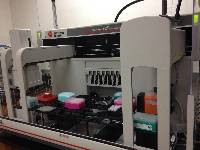Next Generation Sequencing (NGS) Illumina Library Prep
We perform Illumina NGS library preparation from a variety of starting materials, including genomic DNA, PCR products, BACs, total RNA, and mRNA. These NGS libraries could be sequenced with various Illumina's platforms such as the MiSeq Personal System, NextSeq 500, NovaSeq6000, etc. Applications include de novo sequencing, resequencing of whole genomes and target DNA regions, sequencing of individual chloroplast genomes and metagenomics environmental samples, RNA analysis, and many more.
Sample Submission Requirements (pdf)
For a typical shotgun genome sequencing project provide ~1.0 ug of double-stranded DNA, with the minimal concentration of 50 ng/ul in H2O or EB (Qiagen) buffer, OD (260/280)>1.8. Please provide a photo of an agarose gel documenting the DNA quality. For all other types of samples and additional information please contact Alina Akhunova at akhunova@ksu.edu
NGS Workflow
1) Sample Quality Controls available at IGF: NanoDrop based OD260/280 and OD260/230 measurement; Qubit based quantification; PicoGreen based quantification with Synergy H1 Hybrid Multi-Mode Microplate Reader (BioTek); total RNA/mRNA integrity assessment with Agilent 2100 Bioanalyzer; genomic DNA quality check with Agilent 2200 TapeStation; full-length cDNA/ PCR product quality control with Agilent 2100 Bioanalyzer and more.
2) NGS libraries: depending on the number of submitted samples, the libraries could be constructed with the Biomek FXP plus TRobot Laboratory Automation Workstation. It allows every aspect of liquid handling, including pipetting, dilution, dispensing and integration. The platform is capable of walk-away automation of TruSeq RNA sample prep workflow with current throughput of 200 RNA-seq libraries a week.

Biomek FXP System
3) Library size selection: We are using both Ampure beads and Pippin Prep based size selection.
4) Library QC: Qubit based quantification; quality assessment with Agilent 2100 Bioanalyzer; qPCR based quantification using KAPA reagents.
5) Library dilution, pooling, sequencing or shipping to a NovaSeq facility.